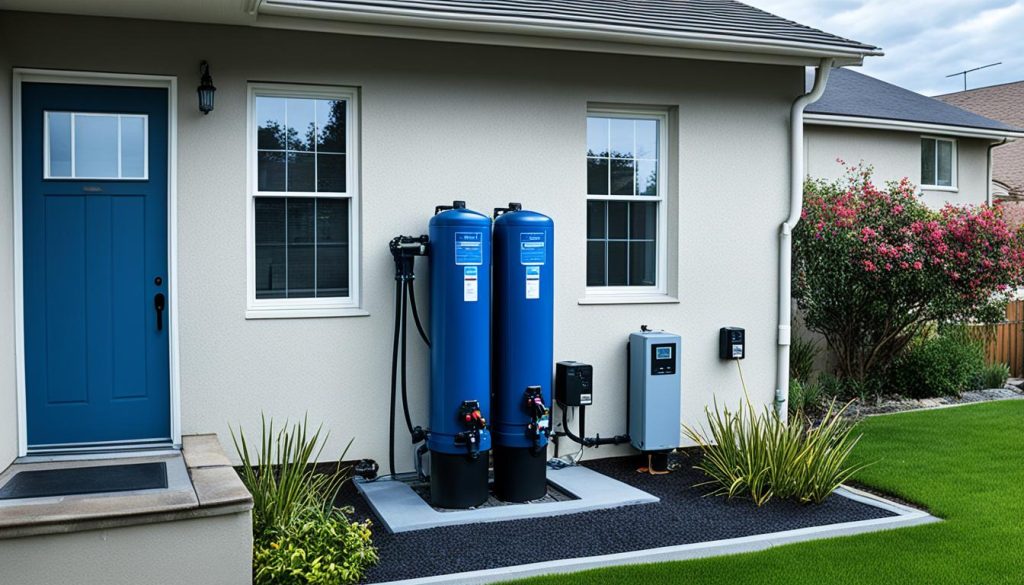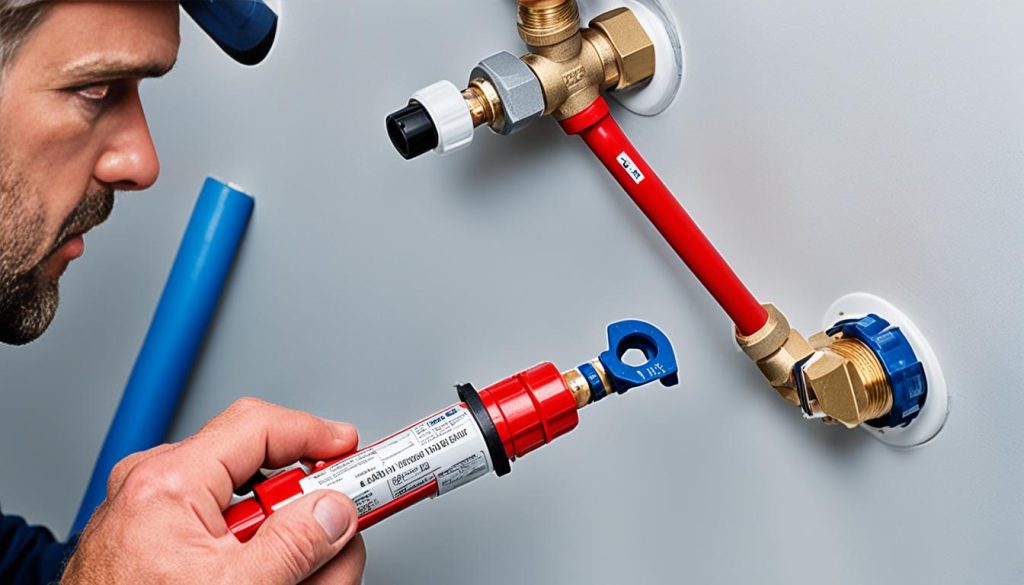Understanding PRVs in Plumbing Essentials
Did you know that high water pressure can cause significant damage to your home’s plumbing system? Without proper regulation, excessively high water pressure can lead to pipe bursts, leaks, and other costly issues. That’s where a Pressure Release Valve (PRV) comes into play.
A PRV is an essential component in plumbing systems that regulates water pressure and protects your home from potential damage. It acts as a safeguard, ensuring that water pressure remains within a safe and desired range, preventing any harmful consequences.
Curious to learn more about what PRVs are, how they work, and why they are crucial for your plumbing system? Keep reading to discover the importance of PRVs and how they can help you maintain a safe and efficient plumbing system.
Key Takeaways:
- A PRV, or Pressure Release Valve, is vital for regulating water pressure in plumbing systems and preventing damage.
- High water pressure can lead to pipe bursts, leaks, and expensive repairs.
- PRVs help save money on utility bills by reducing water consumption.
- Signs that your PRV needs replacing include high, low, or no water pressure, water leaks, and unusual vibration noises.
- Consult a professional plumber for PRV installation, maintenance, and troubleshooting.
How Does a PRV Work?
A Pressure Release Valve (PRV) is a crucial component in plumbing systems that controls the flow and pressure of water. Installed on the main water line entering a building, it plays a vital role in maintaining a safe and consistent water pressure level.
When the water pressure exceeds a certain limit, the PRV automatically releases the excess pressure, ensuring that it remains within the desired range. This mechanism is achieved through a spring-loaded valve inside the PRV.
As water flows through the PRV, the spring-loaded valve acts as a regulator, adjusting the pressure to a safe level. This helps protect the plumbing system from damage that high water pressure can cause.
The PRV’s ability to maintain optimal pressure throughout the plumbing system ensures a consistent flow of water to faucets, showerheads, and appliances. It helps prevent excessive pressure that can lead to leaks, burst pipes, and other plumbing issues.
A properly functioning PRVs not only safeguard your plumbing system but also promote water efficiency. By reducing water pressure to an appropriate level, PRVs minimize water waste, leading to lower utility bills and a more sustainable water usage.
| Benefits of PRVs in Plumbing Systems | Importance of PRVs |
|---|---|
|
|
Benefits of Using a PRV
Using a PRV in your plumbing system offers numerous benefits that can enhance the efficiency, longevity, and safety of your pipes and appliances. Let’s explore these advantages in detail:
1. Protection against Excessive Water Pressure
A PRV is designed to regulate water pressure, preventing it from reaching dangerous levels. By reducing the pressure, a PRV safeguards your pipes and appliances from potential damage caused by the forceful flow of water. This helps maintain the integrity of your plumbing system and reduces the need for costly repairs.
2. Cost Savings on Utility Bills
Installing a PRV can lead to significant savings on your utility bills. By controlling water pressure, a PRV helps decrease water consumption, resulting in lower water bills. It ensures that water is used more efficiently throughout your home, minimizing wastage and unnecessary costs.
3. Prevention of Water Leaks and Damage
A properly functioning PRV plays a crucial role in preventing water leaks and potential water damage in your home. By maintaining optimal water pressure, it helps avoid excessive stress on pipes and fittings, reducing the likelihood of leaks. This contributes to a healthier and safer living environment.
| Benefits | Explanation |
|---|---|
| Protection against damage | Reduces the risk of pipe and appliance damage due to excessive water pressure |
| Cost savings | Reduces water consumption, leading to lower utility bills |
| Prevention of water leaks | Helps maintain optimal water pressure, minimizing the risk of leaks |
Investing in a PRV for your plumbing system is a practical and cost-effective measure that brings various benefits. From protecting your pipes and appliances to reducing utility bills and preventing water damage, a PRV plays a vital role in the overall performance and longevity of your plumbing system. Ensure proper installation and regular maintenance to maximize its advantages.
PRV Installation Guide
Installing a Pressure Release Valve (PRV) in your plumbing system can help maintain safe and consistent water pressure, preventing potential damage and ensuring optimal performance. While it’s recommended to hire a professional plumber for accurate installation, understanding the essential steps involved can provide valuable insights.
Gather the Necessary Tools
Before beginning the installation process, make sure you have the following tools on hand:
- Adjustable wrench
- Plumbing tape (Teflon tape)
- Pipe cutter or hacksaw
- Pipe wrench
- Bucket or towel for potential water spills
Locate the Main Water Line
Prior to installing the PRV, locate the main water line in your home. It is typically found near the water meter. If you are unsure of its exact location, consult your local municipality or a professional plumber for assistance.
Shut Off the Water Supply
Before proceeding, shut off the water supply to avoid any leaks or water damage during the installation process. It’s essential to turn off the main water shut-off valve, which is usually located near the water meter.
Prepare the Pipework
Once the water supply is turned off, you can begin preparing the pipework:
- Measure and mark the section of the main water line where the PRV will be installed. Take note of the pipe diameter as it will determine the size of the PRV.
- Using a pipe cutter or hacksaw, carefully cut the main water line at the marked location. Make sure to wear appropriate safety gear and brace the pipes to prevent any unnecessary movement.
- With an adjustable wrench, remove any burrs or rough edges from the cut ends of the pipe to ensure a clean and secure connection.
Install the PRV
With the pipework prepared, you can proceed with installing the PRV:
- Apply plumbing tape (Teflon tape) to the male threads of both ends of the PRV to create a watertight seal.
- Insert one end of the PRV into the main water line, ensuring a snug fit. Use a pipe wrench to tighten the connection, ensuring it is secure but not over-tightened to avoid damaging the fittings.
- Attach the other end of the PRV to the remaining section of the main water line using the same technique as in the previous step.
Test and Inspect
After the PRV is installed, it’s crucial to test and inspect the system to ensure it functions properly:
- Turn on the main water supply and closely monitor the PRV for any leaks or unusual noises.
- Check the water pressure at various fixtures in your home to ensure it remains within the desired range.
- If you encounter any issues or notice discrepancies, consult a professional plumber for troubleshooting and necessary repairs.
Regular maintenance and inspection of your PRV are essential to ensure optimal performance and prevent potential issues. Schedule periodic checks to verify that the valve is functioning correctly and make any necessary adjustments as recommended by the manufacturer or a qualified plumber.
By following this PRV installation guide and prioritizing proper maintenance, you can effectively regulate your plumbing system’s water pressure and protect your home from potential damage.
Importance of PRVs in Plumbing Systems
When it comes to the stability and safety of plumbing systems, PRVs (Pressure Release Valves) play a crucial role. These valves are essential in maintaining water pressure within the desired range, preventing excessive pressure that can lead to damage. By regulating water pressure, PRVs protect pipes, appliances, and fixtures from wear and tear, ensuring their longevity.
One of the key benefits of PRVs is their ability to maintain a constant flow of water. Without proper pressure regulation, water flow can become inconsistent, causing issues such as reduced water pressure or even no water availability. With PRVs, you can enjoy a steady and reliable flow of water throughout your home, improving the overall performance of your plumbing system.
PRVs are not only important for the stability of your plumbing system but also for the protection of your home. Without these valves, excessive water pressure can lead to water damage, leaks, and costly repairs. By preventing water pressure from reaching dangerous levels, PRVs give you peace of mind, knowing that your plumbing system is safeguarded against potential problems.
Given the importance of PRVs in plumbing systems, it is crucial to prioritize their installation and maintenance. Whether you are building a new home or renovating an existing one, consulting a professional plumber for PRV installation is highly recommended. Additionally, regular inspection and maintenance ensure that these valves continue to function optimally, providing reliable water pressure regulation for years to come.
Source Links
- https://reliabledp.com/what-is-prv-in-plumbing/
- https://uk.rs-online.com/web/content/discovery/ideas-and-advice/pressure-reducing-valves-guide
- https://www.reliancevalves.com/gb/en/resources/blog/ultimate-guide-installing-prvs
- Investing Wisely: How Windows & Doors in Boost Property Value and Financial Health - April 24, 2025
- The Financial Impact of Personal Injuries: Why Legal Help Matters for Business Owners - April 16, 2025
- The Hidden Financial Costs of Domestic Assault: What Business Owners Need to Know - April 16, 2025













